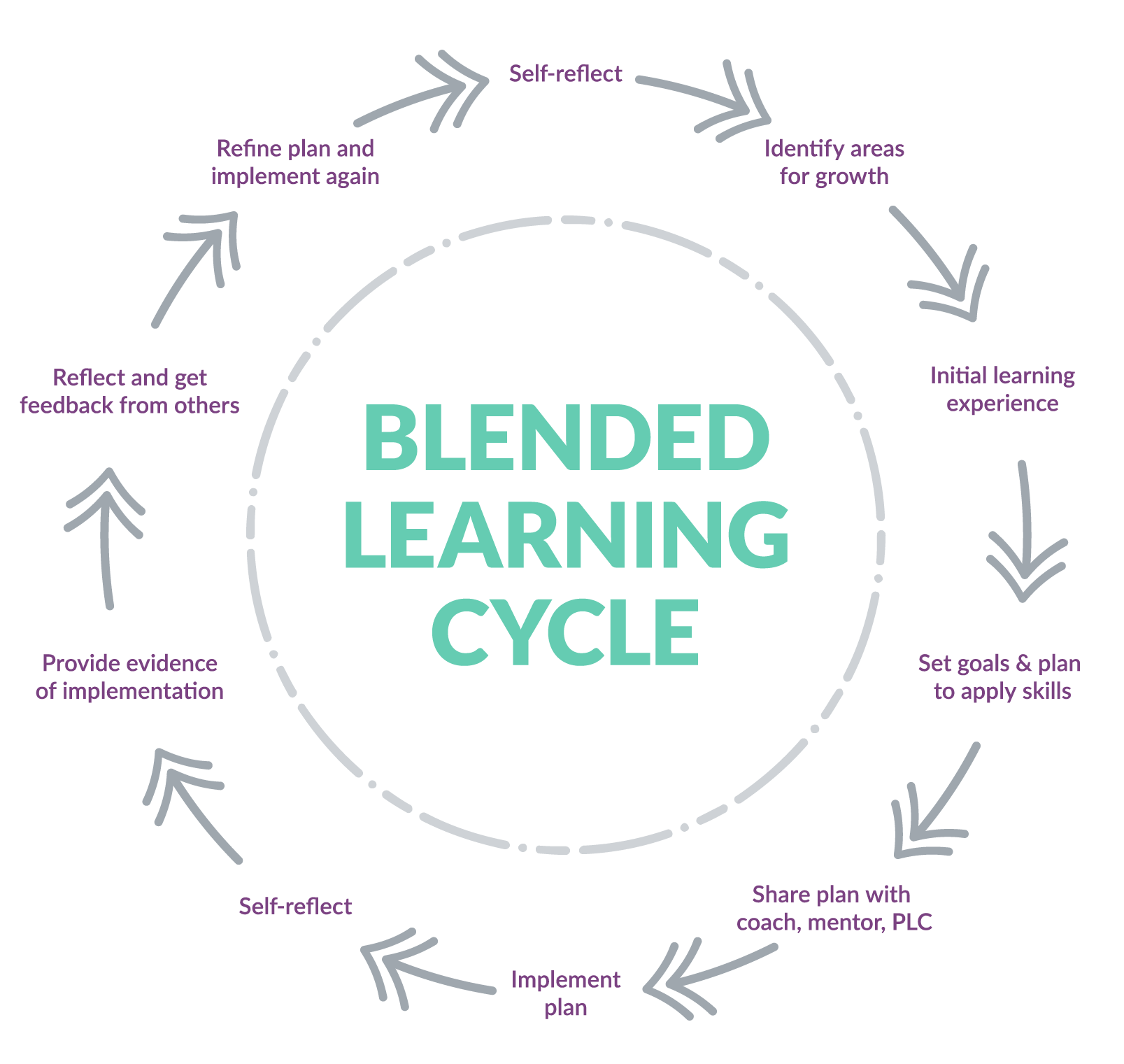Imagine a Michelin-star chef, maybe Gordon Ramsay or Anne-Sophie Pic, crafting a gourmet dish: combining the finest ingredients, precise techniques, and innovative flair to create a culinary masterpiece. Similarly, blended learning for K-12 teachers combines the best elements of traditional in-person instruction with the innovative capabilities of online resources to craft an enriching and effective professional development experience.
In the digital age, where technology is integral to learning and Gen Z students (and educators) are digital natives, this approach not only aligns with modern educational needs but also offers numerous benefits that can significantly enhance the skills, engagement, retention, and confidence of teachers.
Read on to uncover topics like:
- What is Blended Learning?
- Advantages of Blended Learning in K-12 PD
- Who Benefits from Blended Learning?
- Implementing Blended Learning in Your School District
- The Future of Professional Development
What is Blended Learning?
Blended learning integrates the best of both worlds—traditional in-person training and digital resources. This approach allows educators to access materials, engage in interactive activities, and collaborate with peers online, while still benefiting from the personal interaction and immediate feedback of face-to-face sessions. Blended learning can take various forms, such as flipped classrooms, online courses supplemented by in-person workshops, or a mix of synchronous and asynchronous learning activities.

Advantages of Blended Learning in Professional Development
Flexibility and Convenience
One of the most significant advantages of blended learning is its flexibility. Teachers can access online modules and resources at their own pace and on their own schedule. Flexible professional development is particularly beneficial for educators who often juggle multiple responsibilities and may find it challenging to attend in-person workshops regularly.
Personalized Learning for Teachers
Blended learning allows for a more personalized approach to professional development. Educators can choose courses and modules that align with their specific interests, needs, and skill levels. This tailored learning experience can lead to more effective and meaningful professional growth.
Cost-Effectiveness
Blended learning can be a more cost-effective teacher training solution for school districts. It reduces the need for travel and accommodation expenses associated with traditional professional development seminars. Additionally, online resources can be reused and updated as needed, providing long-term value.
Increased Engagement
Interactive online platforms can make professional development activities more engaging. Features such as discussion forums, quizzes, and multimedia content can enhance understanding and retention. The combination of different teaching methods caters to various learning styles, making professional learning activities more inclusive.
Collaborative Opportunities
Blended learning transforms professional development into a vibrant, interconnected community of practice. By leveraging digital platforms and face-to-face interactions, this approach creates a rich tapestry of collaboration that extends far beyond traditional boundaries. Teachers can also connect with peers from different schools or districts, broadening their professional network and learning from a diverse group of educators.
Real-Time Feedback and Support
Online components of blended learning often include immediate feedback through quizzes and interactive activities. Educators can also receive ongoing support from instructors and peers through online discussion boards and virtual meetings, helping them to apply new strategies in their classrooms effectively. Blended learning really revolutionizes the PD feedback loop, cultivating a dynamic and responsive environment.
Hand-picked content for you:
[Deep Dive] Effective Professional Learning Strateiges (That Actually Work)
The Risk of Outdated Professional Development
Sticking with outdated professional development methods can have several negative consequences:
- Decreased Engagement: Traditional methods might not hold the attention of modern educators who are used to interactive and tech-savvy environments.
- Lack of Data Integrity: Using disparate systems for PD can result in data silos, making it difficult to track and analyze professional development progress accurately.
- Limited Reach: In-person-only sessions can limit participation, especially for educators with tight schedules or those in remote areas.
- Higher Costs: Relying on multiple vendors for certification credits, learning management systems (LMS), content, compliance, and PD events can be expensive. The expenses related to travel, accommodations, and printed materials can also add up, straining school PD budgets.
- Inefficiency: One-size-fits-all training sessions may not address the specific needs of individual teachers, leading to less effective professional growth.
- Losing Candidates: School districts that rely on outdated PD methods may lose potential teaching candidates to other districts that offer more modern, flexible, and appealing professional development opportunities.
- Negative Perception: Newer generation teachers might perceive schools with outdated PD as “old school” and less innovative, potentially affecting their decision to stay long-term or their overall job satisfaction.
By not adopting blended learning, schools risk falling behind in providing relevant and effective professional development, ultimately impacting teacher performance and student outcomes.
Hand-picked content for you:
[On-Demand Webinar] Adapting PD in an Era of Teacher Shortages
Who Benefits from Blended Learning?
Blended learning isn’t just advantageous for teachers; it benefits the entire district and school community:
Teachers
Gain flexibility, personalized learning, and opportunities for collaboration and immediate feedback.
Students
Indirectly benefit from having better-prepared and more engaged teachers who bring fresh ideas and strategies into the classroom.
School Districts
Save on costs, provide more effective training, and support a culture of continuous improvement and innovation.
Administrators
Can track professional development progress more efficiently and ensure that training aligns with district goals and standards.
Hand-picked content for you:
Enhancing Teacher Support through Innovative Mentoring at Brevard County
Implementing Blended Learning in Your School District
To successfully integrate blended learning into your district’s professional development programs, consider the following steps:
1. Assess Needs and Goals: Conduct a needs assessment to determine the specific professional development needs of your teachers. Set clear goals for what you hope to achieve with blended learning.
2. Choose the Right Platform: Select a robust and user-friendly online learning platform that can support various types of content and interaction. Ensure that it integrates well with existing systems and is accessible to all educators.
3. Develop High-Quality Content: Create engaging and relevant content that meets the needs of your teachers. Incorporate a mix of videos, readings, interactive activities, and assessments.
4. Provide Training and Support: Offer training sessions to help teachers become comfortable with the new platform and blended learning approach. Provide ongoing technical support to address any issues that arise.
5. Evaluate and Adjust: Continuously evaluate the effectiveness of your blended learning programs through feedback and performance data. Be prepared to make adjustments to improve the learning experience.
Hand-picked content for you:
[eBook] Innovative Professional Learning and Mentoring Strategies
The Future of Professional Development
The blended learning concept is simple, but it’s flexible enough to meet the needs of almost any individual or group. And the benefits are nothing to brush off: time that would have been required teach a workshop can now be reclaimed (saving money on substitute teachers) or used for collaboration and application.
The search for more effective ways to teach students never ends. You research. You get creative. You lean in, put your weight into it. You do these things because knowledge — and the skills to gain knowledge — equips students for success in life. What would it look like to apply some of these ideas to professional learning? To move past the sit-and-get workshop? To find creative ways to provide the kind of learning opportunities each individual teacher needs and wants? Blended professional learning is a great place to start.
By leveraging the advantages of both in-person and online learning, blended learning can empower teachers to achieve their professional goals and improve student outcomes. As we continue to embrace digital transformation in education, blended learning will undoubtedly play a pivotal role in shaping the future of professional development.
Interested in learning more about Frontline Professional Growth?
Erin Shelton
Erin is a writer and member of the award-winning content team at Frontline Education. With experience in education, she is passionate about creating content that helps to support and impact the growth of both students and teachers.
